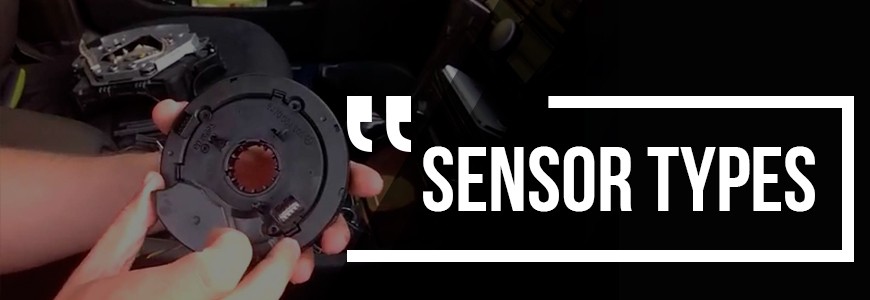
There are slathers of sensors that control the work of various systems. This article describes the three existing types of steering angle sensors. These sensors measure the steering wheel position (shaft) in the range of 1440 degrees that is equal to 4 complete turns of the steering wheel. The sensors are usually mounted on the steering column or on the steering control valve. In total there are 3 types of such sensors: potentiometric or resistive, optical and magnetoresistive. Let’s get a closer view:
Potentiometer sensor. It is designed in the figure of a variable resistor or potentiometer. Potentiometers are located so that the relative angle between their location is 90 degrees. It allows you to elaborate the angle of rotation, as for each position there are 2 parameters by which the control unit calculates the angle of rotation.
- Moving contact
- Resistance track
- Moving contact output
- Output minus

This figure shows the conditional structure of a potentiometric or resistive angle sensor.
General principles of the potentiometric sensor:
When the driver turns the steering wheel, the moving contact attached to the shaft changes its position and the sensor resistance changes. The control unit takes these changes and calculates the angle and side of the turn. The electric power starts to strengthen and help the driver to drive a car.
The disadvantage of this sensor is the presence of sliding contacts, that is more of a risk configuration compared with other sensorstypes.
Optical sensor. It consists of an opto relay, a coding disk and a complete turn control unit.



When the steering wheel turns, the light from the infrared LED gets on the optical receiver (photoresistor) through the coding disk. Voltage pulses are generated in the sensor circuit and the control unit calculates the direction and rotation angle of the steering wheel from the data obtained.
Magnetoresistive sensor. It is the most complicated of the previous presented. The sensor configuration has anisotropic magnetoresistive sensors. The electrical resistance of these sensors varies with external magnetic field. This type of sensor calculates the rotation angle within 1440 degrees by measuring therotation angle of two gears, which are driven by a pinion gear mounted on the steering shaft. Both gears have a difference in one tooth. Thus, for each position of the steering shaft, there is a unique pair of parameters of the rotation angle.
1. Steering column; 2. Hall sensors; 3. Gear with n number of teeth, measuring; 4. Electronic board; 5. Permanent magnets; 6Pinion gear mounted on the shaft; 7. Measuring gear with n + 1 teeth.
Major features of the sensor breakage
The rotation sensor is an electromechanical device. Its designhas weak points inside, these are wiring and some details. If a protective boot bursts, the shaft becomes rusty and the sensor may corrode. When the sensor is mounted on a rack, dust can get on its surface, that leads to electrical failures and the sensor damage.
Breakage features:
- Indicator lamp mounted on the instrument panel indicating that a system has breakage
- The steering wheel is stiff to rotate, with shocks;
- Electric power can helpto rotate the steering wheel in one direction only
When there is a problem in the rotation angle sensor, you need to contact the service station specialists who are engaged in diagnostics and repair of the power steering system. An experienced specialist, with the help of specialized equipment and tools, will be able to detect and eliminate the cause of the breakdown.



COMMENTS